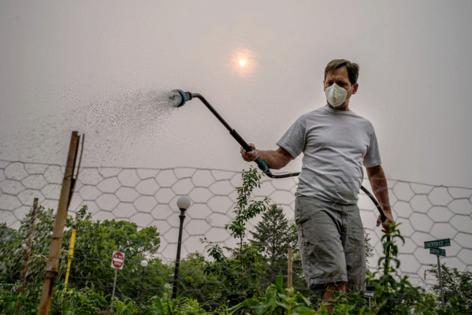What wildfire smoke is doing to your health
Published in Health & Fitness
MINNEAPOLIS -- Wildfire smoke has been easy to spot in Minnesota this week, coating the Twin Cities in a brownish haze that obscured the downtown skylines. But experts in lung health are more concerned about the particles you can’t see.
Particles in the smoke are so small that they can evade some of the lung’s natural defenses, causing not only breathing problems but also other health concerns if they enter the bloodstream. Smoke particles are typically less than 2.5 micrometers in diameter, making them at least four times smaller than dust or pollen and 10 times smaller than sand grains.
“You can just think of them as little sandpapers and you inhale them and they are just in your lungs kind of irritating, irritating, irritating,” said Jessie Carr, an environmental epidemiology supervisor for the Minnesota Department of Health, who linked her gravelly voice Thursday to walking her dog Wednesday night. “And the smaller the particles, the deeper they get into your lungs.”
Air quality alerts because of wildfire smoke have been issued 30 times so far this year by the Minnesota Pollution Control Agency. That brings the state closer to the 41 alerts issued in parts of Minnesota in 2023 and the 37 alerts in 2021. The five-day statewide alert issued this week through Saturday is tied for Minnesota’s longest.
Preliminary state research has found an increase in emergency room visits during and immediately after wildfire smoke alerts in Minnesota. ER trips mostly increase among children and adults with respiratory conditions such as asthma and chronic obstructive pulmonary disease (COPD) that make them vulnerable to complications from smoke exposure.
Carr said the Health Department will be monitoring ER visits after future exposure events to validate the initial research. However, she said there is more than enough evidence over the health risks of wildfire smoke exposure to support its public health recommendations.
The Centers for Disease Control and Prevention found an uptick in heart attacks causing ER visits in the Midwest in 2023 on days when wildfire smoke resulted in poor air quality. Other patients are treated for bronchitis, severe asthma flare-ups and even strokes.
Prevention tips for people at elevated risk of health complications include staying indoors in air-conditioned environments. Basic surgical masks don’t reduce smoke exposure, but fitted N95 masks can help. Switching air conditioning in cars to the recirculating mode can help as well.
Carr said solutions often need to be localized; many people in Grand Marais don’t have air conditioning because of the cooler climate along the Lake Superior shoreline, and yet they are often in the path of wildfire smoke plumes.
While the risks remain greatest for people with pre-existing conditions, doctors urged Minnesotans to beware if they start to feel short of breath, especially during outdoor activities. People at low risk who start to feel effects should get indoors and hydrate, said Dr. Alec Duffy, an internal medicine and pediatric hospitalist at M Health Fairview.
“Try not to do things in the house that lead to indoor pollution and particulate matter. So even candles, cooking at a high heat, things like that,” he said.
Duffy’s wife is pregnant and needs to move around, but the couple shortened their walks this week, as pregnant women also appear susceptible to complications from wildfire smoke exposure.
Health problems are largely the result of inflammation and swelling in the body as it responds to the inhaled particles. Inflammation clears with time, but researchers are examining what happens when multiple exposure episodes cause it to happen over and over again.
Limited research in wildland firefighters has found some evidence of diminished lung function as a result of repeated exposures to wildfire smoke, according to the Environmental Protection Agency, but there is no data on the harms from long-term exposure.
Studies do show changes in the body even when people don’t feel symptoms, said Dr. Matthew Prekker, a pulmonary and critical care specialist for Hennepin Healthcare in Minneapolis.
“We can actually prove that even healthy folks can have a decrease in the amount of air they’re able to force out of their lungs ... even though they may not have a whole lot of symptoms as they go about their daily activities,” Prekker said.
On Thursday, Minneapolis ranked as having the third- or fourth-worst air quality of major cities in the world, according to IQAir, which aggregates global pollution data.
Prekker said July is usually low tide for respiratory problems compared to the flu season at Hennepin Healthcare in Minneapolis, but that changes during wildfire alerts.
The primary air quality concern right now is the smoke itself, but that could change over the weekend as the smoke thins out and sunshine increases, according to the latest MPCA forecast. The organic compounds in the smoke can interact with the sunlight in a way that produces ozone, which can be a pollutant at ground level and cause inflammation and other health problems as well.
“Ozone is good when it’s six miles above the earth in the ozone layer, protecting us from UV radiation,” Prekker said, “but ozone is not good when it’s on the surface in the air that we breathe.”
©2025 The Minnesota Star Tribune. Visit at startribune.com. Distributed by Tribune Content Agency, LLC.










Comments